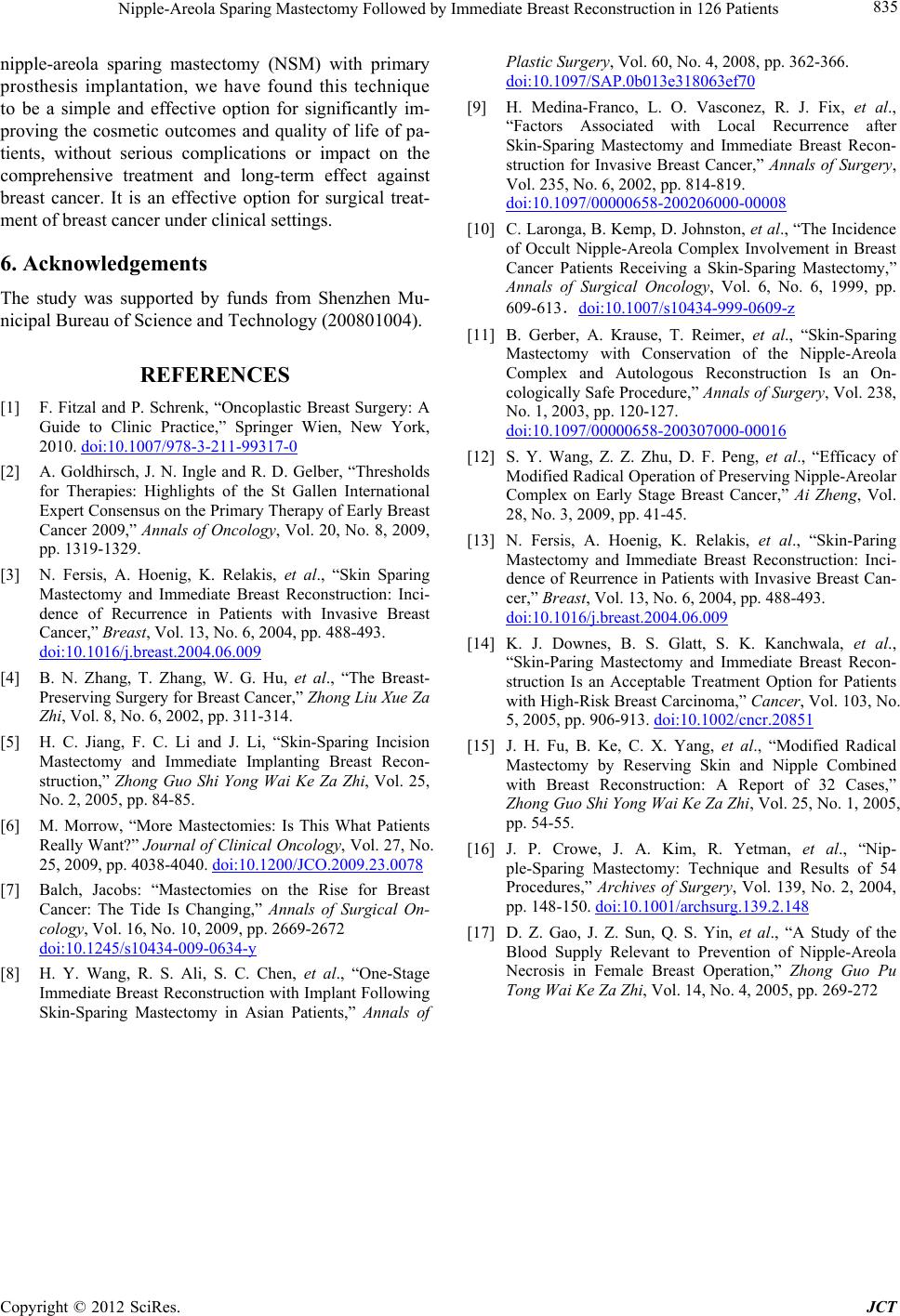
Nipple-Areola Sparing Mastectomy Followed by Immediate Breast Reconstruction in 126 Patients
Copyright © 2012 SciRes. JCT
835
nipple-areola sparing mastectomy (NSM) with primary
prosthesis implantation, we have found this technique
to be a simple and effective option for significantly im-
proving the cosmetic outcomes and quality of life of pa-
tients, without serious complications or impact on the
comprehensive treatment and long-term effect against
breast cancer. It is an effective option for surgical treat-
ment of breast cancer under clinical settings.
6. Acknowledgements
The study was supported by funds from Shenzhen Mu-
nicipal Bureau of Science and Technology (200801004).
REFERENCES
[1] F. Fitzal and P. Schrenk, “Oncoplastic Breast Surgery: A
Guide to Clinic Practice,” Springer Wien, New York,
2010. doi:10.1007/978-3-211-99317-0
[2] A. Goldhirsch, J. N. Ingle and R. D. Gelber, “Thresholds
for Therapies: Highlights of the St Gallen International
Expert Consensus on the Primary Therapy of Early Breast
Cancer 2009,” Annals of Oncology, Vol. 20, No. 8, 2009,
pp. 1319-1329.
[3] N. Fersis, A. Hoenig, K. Relakis, et al., “Skin Sparing
Mastectomy and Immediate Breast Reconstruction: Inci-
dence of Recurrence in Patients with Invasive Breast
Cancer,” Breast, Vol. 13, No. 6, 2004, pp. 488-493.
doi:10.1016/j.breast.2004.06.009
[4] B. N. Zhang, T. Zhang, W. G. Hu, et al., “The Breast-
Preserving Surgery for Breast Cancer,” Zhong Liu Xue Za
Zhi, Vol. 8, No. 6, 2002, pp. 311-314.
[5] H. C. Jiang, F. C. Li and J. Li, “Skin-Sparing Incision
Mastectomy and Immediate Implanting Breast Recon-
struction,” Zhong Guo Shi Yong Wai Ke Za Zhi, Vol. 25,
No. 2, 2005, pp. 84-85.
[6] M. Morrow, “More Mastectomies: Is This What Patients
Really Want?” Journal of Clinical Oncology, Vol. 27, No.
25, 2009, pp. 4038-4040. doi:10.1200/JCO.2009.23.0078
[7] Balch, Jacobs: “Mastectomies on the Rise for Breast
Cancer: The Tide Is Changing,” Annals of Surgical On-
cology, Vol. 16, No. 10, 2009, pp. 2669-2672
doi:10.1245/s10434-009-0634-y
[8] H. Y. Wang, R. S. Ali, S. C. Chen, et al., “One-Stage
Immediate Breast Reconstruction with Implant Following
Skin-Sparing Mastectomy in Asian Patients,” Annals of
Plastic Surgery, Vol. 60, No. 4, 2008, pp. 362-366.
doi:10.1097/SAP.0b013e318063ef70
[9] H. Medina-Franco, L. O. Vasconez, R. J. Fix, et al.,
“Factors Associated with Local Recurrence after
Skin-Sparing Mastectomy and Immediate Breast Recon-
struction for Invasive Breast Cancer,” Annals of Surgery,
Vol. 235, No. 6, 2002, pp. 814-819.
doi:10.1097/00000658-200206000-00008
[10] C. Laronga, B. Kemp, D. Johnston, et al., “The Incidence
of Occult Nipple-Areola Complex Involvement in Breast
Cancer Patients Receiving a Skin-Sparing Mastectomy,”
Annals of Surgical Oncology, Vol. 6, No. 6, 1999, pp.
609-613.doi:10.1007/s10434-999-0609-z
[11] B. Gerber, A. Krause, T. Reimer, et al., “Skin-Sparing
Mastectomy with Conservation of the Nipple-Areola
Complex and Autologous Reconstruction Is an On-
cologically Safe Procedure,” Annals of Surgery, Vol. 238,
No. 1, 2003, pp. 120-127.
doi:10.1097/00000658-200307000-00016
[12] S. Y. Wang, Z. Z. Zhu, D. F. Peng, et al., “Efficacy of
Modified Radical Operation of Preserving Nipple-Areolar
Complex on Early Stage Breast Cancer,” Ai Zheng, Vol.
28, No. 3, 2009, pp. 41-45.
[13] N. Fersis, A. Hoenig, K. Relakis, et al., “Skin-Paring
Mastectomy and Immediate Breast Reconstruction: Inci-
dence of Reurrence in Patients with Invasive Breast Can-
cer,” Breast, Vol. 13, No. 6, 2004, pp. 488-493.
doi:10.1016/j.breast.2004.06.009
[14] K. J. Downes, B. S. Glatt, S. K. Kanchwala, et al.,
“Skin-Paring Mastectomy and Immediate Breast Recon-
struction Is an Acceptable Treatment Option for Patients
with High-Risk Breast Carcinoma,” Cancer, Vol. 103, No.
5, 2005, pp. 906-913. doi:10.1002/cncr.20851
[15] J. H. Fu, B. Ke, C. X. Yang, et al., “Modified Radical
Mastectomy by Reserving Skin and Nipple Combined
with Breast Reconstruction: A Report of 32 Cases,”
Zhong Guo Shi Yong Wai Ke Za Zhi, Vol. 25, No. 1, 2005,
pp. 54-55.
[16] J. P. Crowe, J. A. Kim, R. Yetman, et al., “Nip-
ple-Sparing Mastectomy: Technique and Results of 54
Procedures,” Archives of Surgery, Vol. 139, No. 2, 2004,
pp. 148-150. doi:10.1001/archsurg.139.2.148
[17] D. Z. Gao, J. Z. Sun, Q. S. Yin, et al., “A Study of the
Blood Supply Relevant to Prevention of Nipple-Areola
Necrosis in Female Breast Operation,” Zhong Guo Pu
Tong Wai Ke Za Zhi, Vol. 14, No. 4, 2005, pp. 269-272